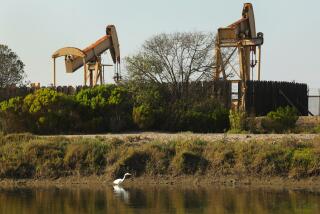Preserve to Rebuild a Prairie Ecosystem : Nature: U.S. will re-create the sea of 7-foot grass seen by 19th-Century settlers on land originally intended for a nuclear power plant.
- Share via
PRAIRIE CITY, Iowa — Native plants such as big bluestem and Indian grass will thrive again in a new preserve in the heart of the tallgrass prairie, on land once set aside for a nuclear power plant.
The U.S. Fish and Wildlife Service is preparing to plow prime farm land and attempt to re-create the sea of grasses up to 7 feet tall that white settlers found in the mid-1800s when they migrated here from the forested East.
“We’re starting with a clean slate in terms of habitat here,” said the agency’s Richard Birger, the man in charge of establishing the 8,600-acre Walnut Creek National Wildlife Refuge in central Iowa.
Nearly half the site had been bought by an Iowa utility for a nuclear power plant that was never built. Scuttling the project left about 3,600 acres of fields and timber in the hands of a single non-farming owner.
The land happened to be in the district of Rep. Neal Smith, a senior member of the House Appropriations Committee. “I’ve had this idea about needing this kind of park for quite a while,” Smith said.
Congress appropriated $6 million last year for the project; the refuge and an information center are expected to cost $10 million.
The first step is acquiring the land. Details of the power plant site purchase should be completed soon, Smith said. Adjacent farms are also needed, but no one is being forced to sell, so the acquisition could take 20 years, Smith said.
The tallgrass prairie comprised nearly all of what became Iowa and parts of Indiana, Illinois, Kansas, Missouri, North Dakota, Oklahoma, South Dakota, Nebraska and Wisconsin.
“At one time, 85% of Iowa or more was in tallgrass prairie ecosystem. Now, less than half of 1% of that is left,” Birger said.
The grasses often grew higher than a man stood. Trees were scarce because of periodic fires that swept the land.
Farther west, shorter grasses prevailed. “It’s directly related to rainfall. The wetter the area, the taller the grass,” Birger said.
This is the first major attempt by the Fish and Wildlife Service to reverse a conversion to farming and recreate a prairie.
“In the past we’ve always been oriented toward preserving a natural habitat that’s been beaten up,” Birger said. “Here, we’re reconstructing something was once here and no longer exists.”
The refuge is expected to be open by 1995, and some areas may be accessible to the public next year. Plans include a central building where visitors can learn about plant and animal life on the prairie.
“They’ll try to have the habitat for something over 300 species of birds, as well as all kinds of animals that are indigenous to the area,” Smith said. “There will be a limited number of elk and bison, because they were indigenous to the area.”
Birger said the refuge also will serve as a research laboratory of the prairie ecosystem, so parts of it will be off-limits to the public.
“We’ll have a lot of these animals viewable, but there will be a lot of areas where we won’t have any intrusion,” Birger said. “That’s a balance that we have to strike.”
Smith said the site will be unique among the Fish and Wildlife Service’s more than 430 refuges, which most often are just protected areas for animals such as migratory waterfowl.
“They don’t have another one quite like this one. They have a number of refuges where they just take land and put a fence around it,” Smith said.
More to Read
Sign up for Essential California
The most important California stories and recommendations in your inbox every morning.
You may occasionally receive promotional content from the Los Angeles Times.













